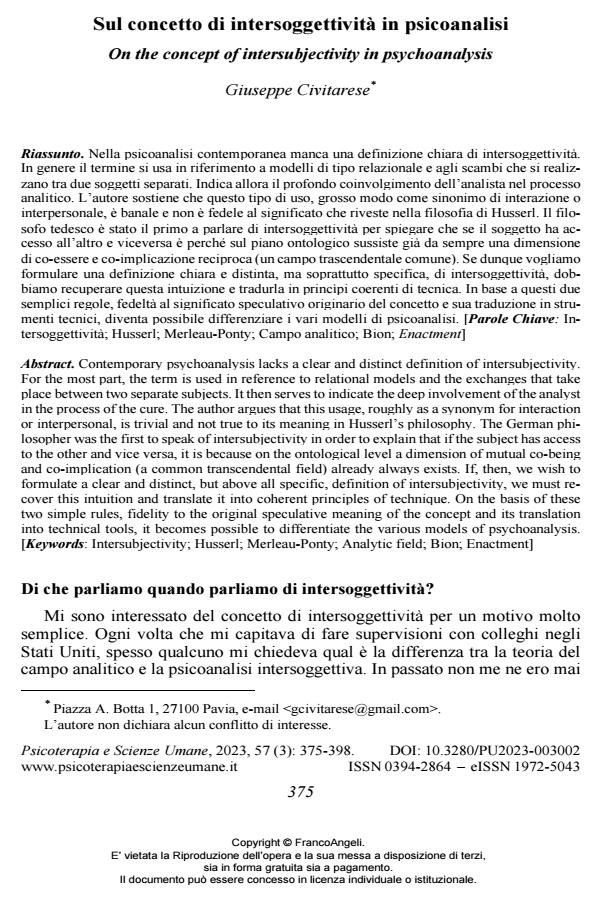On the concept of intersubjectivity in psychoanalysis
Journal title PSICOTERAPIA E SCIENZE UMANE
Author/s Giuseppe Civitarese
Publishing Year 2023 Issue 2023/3
Language Italian Pages 24 P. 375-398 File size 146 KB
DOI 10.3280/PU2023-003002
DOI is like a bar code for intellectual property: to have more infomation
click here
Below, you can see the article first page
If you want to buy this article in PDF format, you can do it, following the instructions to buy download credits

FrancoAngeli is member of Publishers International Linking Association, Inc (PILA), a not-for-profit association which run the CrossRef service enabling links to and from online scholarly content.
Contemporary psychoanalysis lacks a clear and distinct definition of intersubjectivity. For the most part, the term is used in reference to relational models and the exchanges that take place between two separate subjects. It then serves to indicate the deep involvement of the analyst in the process of the cure. The author argues that this usage, roughly as a synonym for interaction or interpersonal, is trivial and not true to its meaning in Husserl’s philosophy. The German phi- losopher was the first to speak of intersubjectivity in order to explain that if the subject has access to the other and vice versa, it is because on the ontological level a dimension of mutual co-being and co-implication (a common transcendental field) already always exists. If, then, we wish to formulate a clear and distinct, but above all specific, definition of intersubjectivity, we must re- cover this intuition and translate it into coherent principles of technique. On the basis of these two simple rules, fidelity to the original speculative meaning of the concept and its translation into technical tools, it becomes possible to differentiate the various models of psychoanalysis.
Keywords: Intersubjectivity; Husserl; Merleau-Ponty; Analytic field; Bion; Enactment]
- Essere o non essere Habermas. Una risposta alla controreplica di Mauro Fornaro Giuseppe Civitarese, in PSICOTERAPIA E SCIENZE UMANE 3/2023 pp.449
DOI: 10.3280/PU2023-003007 - Un approccio estetico allo Sviluppo Organizzativo. In dialogo con Pagliarani Francesco Liuzzi, Alessandro Kadolph, in EDUCAZIONE SENTIMENTALE 39/2024 pp.107
DOI: 10.3280/EDS2023-039011 - Perché Husserl non quadra col campo psicoanalitico e altre annotazioni. Replica a Giuseppe Civitarese Mauro Fornaro, in PSICOTERAPIA E SCIENZE UMANE 3/2023 pp.413
DOI: 10.3280/PU2023-003004 - Considerazioni sull'articolo di Giuseppe Civitarese "Sul concetto di intersoggettività in psicoanalisi" Filippo Maria Ferro, Giuseppe Riefolo, in PSICOTERAPIA E SCIENZE UMANE 3/2023 pp.399
DOI: 10.3280/PU2023-003003 - Il valore dell'intertestualità per il progresso della psicoanalisi. Replica ai commenti di F.M. Ferro & G. Riefolo e di M. Fornaro al saggio "Sul concetto di intersoggettività in psicoanalisi" Giuseppe Civitarese, in PSICOTERAPIA E SCIENZE UMANE 3/2023 pp.423
DOI: 10.3280/PU2023-003005 - On Bion’s Concept of Truth in an Extra-Moral Sense Giuseppe Civitarese, in The American Journal of Psychoanalysis /2023 pp.495
DOI: 10.1057/s11231-023-09430-w
Giuseppe Civitarese, Sul concetto di intersoggettività in psicoanalisi in "PSICOTERAPIA E SCIENZE UMANE" 3/2023, pp 375-398, DOI: 10.3280/PU2023-003002